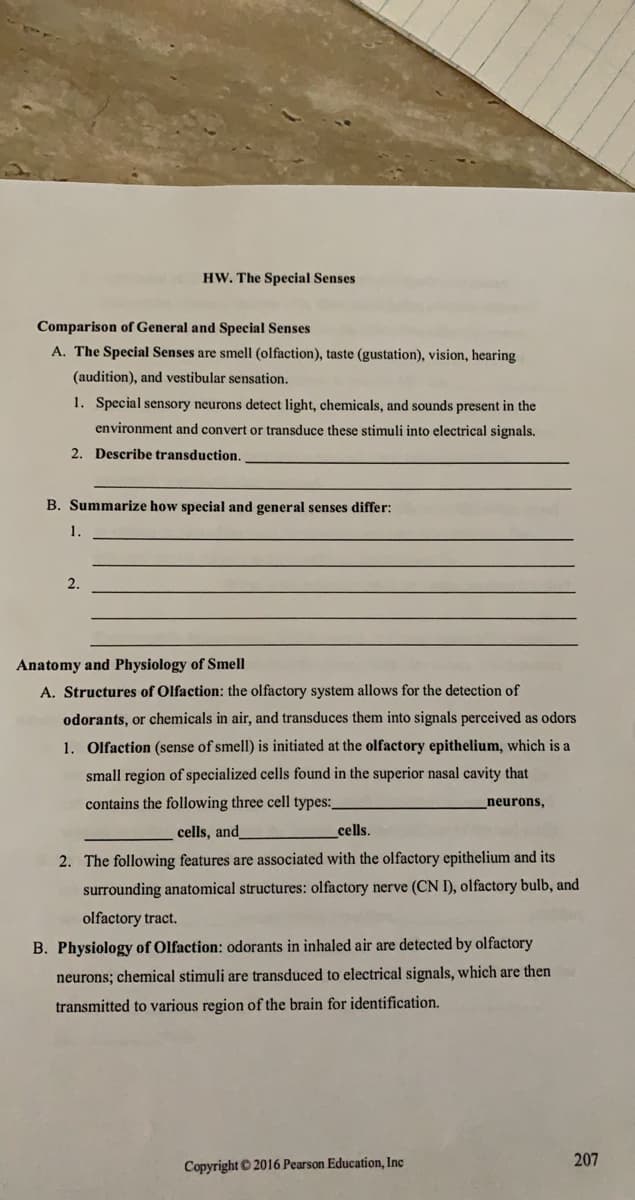HW. The Special Senses Comparison of General and Special Senses A. The Special Senses are smell (olfaction), taste (gustation), vision, hearing (audition), and vestibular sensation. 1. Special sensory neurons detect light, chemicals, and sounds present in the environment and convert or transduce these stimuli into electrical signals. 2. Describe transduction. B. Summarize how special and general senses differ: 1. 2. Anatomy and Physiology of Smell A. Structures of Olfaction: the olfactory system allows for the detection of odorants, or chemicals in air, and transduces them into signals perceived as odors 1. Olfaction (sense of smell) is initiated at the olfactory epithelium, which is a small region of specialized cells found in the superior nasal cavity that contains the following three cell types: neurons, cells, and cells. 2. The following features are associated with the olfactory epithelium and its surrounding anatomical structures: olfactory nerve (CN I), olfactory bulb, and olfactory tract. B. Physiology of Olfaction: odorants in inhaled air are detected by olfactory neurons; chemical stimuli are transduced to electrical signals, which are then transmitted to various region of the brain for identification.
HW. The Special Senses Comparison of General and Special Senses A. The Special Senses are smell (olfaction), taste (gustation), vision, hearing (audition), and vestibular sensation. 1. Special sensory neurons detect light, chemicals, and sounds present in the environment and convert or transduce these stimuli into electrical signals. 2. Describe transduction. B. Summarize how special and general senses differ: 1. 2. Anatomy and Physiology of Smell A. Structures of Olfaction: the olfactory system allows for the detection of odorants, or chemicals in air, and transduces them into signals perceived as odors 1. Olfaction (sense of smell) is initiated at the olfactory epithelium, which is a small region of specialized cells found in the superior nasal cavity that contains the following three cell types: neurons, cells, and cells. 2. The following features are associated with the olfactory epithelium and its surrounding anatomical structures: olfactory nerve (CN I), olfactory bulb, and olfactory tract. B. Physiology of Olfaction: odorants in inhaled air are detected by olfactory neurons; chemical stimuli are transduced to electrical signals, which are then transmitted to various region of the brain for identification.
Human Biology (MindTap Course List)
11th Edition
ISBN:9781305112100
Author:Cecie Starr, Beverly McMillan
Publisher:Cecie Starr, Beverly McMillan
Chapter14: Sensory Systems
Section: Chapter Questions
Problem 12SQ: Match each of the following terms with the appropriate description. _____ somatic senses (general...
Related questions
Question
fill in blanks.

Transcribed Image Text:HW. The Special Senses
Comparison of General and Special Senses
A. The Special Senses are smell (olfaction), taste (gustation), vision, hearing
(audition), and vestibular sensation.
1. Special sensory neurons detect light, chemicals, and sounds present in the
environment and convert or transduce these stimuli into electrical signals.
2. Describe transduction.
B. Summarize how special and general senses differ:
1.
2.
Anatomy and Physiology of Smell
A. Structures of Olfaction: the olfactory system allows for the detection of
odorants, or chemicals in air, and transduces them into signals perceived as odors
1. Olfaction (sense of smell) is initiated at the olfactory epithelium, which is a
small region of specialized cells found in the superior nasal cavity that
contains the following three cell types:
neurons,
cells, and
cells.
2. The following features are associated with the olfactory epithelium and its
surrounding anatomical structures: olfactory nerve (CN I), olfactory bulb, and
olfactory tract.
B. Physiology of Olfaction: odorants in inhaled air are detected by olfactory
neurons; chemical stimuli are transduced to electrical signals, which are then
transmitted to various region of the brain for identification.
207
Copyright © 2016 Pearson Education, Inc
Expert Solution
This question has been solved!
Explore an expertly crafted, step-by-step solution for a thorough understanding of key concepts.
This is a popular solution!
Trending now
This is a popular solution!
Step by step
Solved in 2 steps

Knowledge Booster
Learn more about
Need a deep-dive on the concept behind this application? Look no further. Learn more about this topic, biology and related others by exploring similar questions and additional content below.Recommended textbooks for you

Human Biology (MindTap Course List)
Biology
ISBN:
9781305112100
Author:
Cecie Starr, Beverly McMillan
Publisher:
Cengage Learning

Biology: The Dynamic Science (MindTap Course List)
Biology
ISBN:
9781305389892
Author:
Peter J. Russell, Paul E. Hertz, Beverly McMillan
Publisher:
Cengage Learning

Biology 2e
Biology
ISBN:
9781947172517
Author:
Matthew Douglas, Jung Choi, Mary Ann Clark
Publisher:
OpenStax

Human Biology (MindTap Course List)
Biology
ISBN:
9781305112100
Author:
Cecie Starr, Beverly McMillan
Publisher:
Cengage Learning

Biology: The Dynamic Science (MindTap Course List)
Biology
ISBN:
9781305389892
Author:
Peter J. Russell, Paul E. Hertz, Beverly McMillan
Publisher:
Cengage Learning

Biology 2e
Biology
ISBN:
9781947172517
Author:
Matthew Douglas, Jung Choi, Mary Ann Clark
Publisher:
OpenStax

Human Physiology: From Cells to Systems (MindTap …
Biology
ISBN:
9781285866932
Author:
Lauralee Sherwood
Publisher:
Cengage Learning

Biology: The Unity and Diversity of Life (MindTap…
Biology
ISBN:
9781305073951
Author:
Cecie Starr, Ralph Taggart, Christine Evers, Lisa Starr
Publisher:
Cengage Learning

Biology: The Unity and Diversity of Life (MindTap…
Biology
ISBN:
9781337408332
Author:
Cecie Starr, Ralph Taggart, Christine Evers, Lisa Starr
Publisher:
Cengage Learning